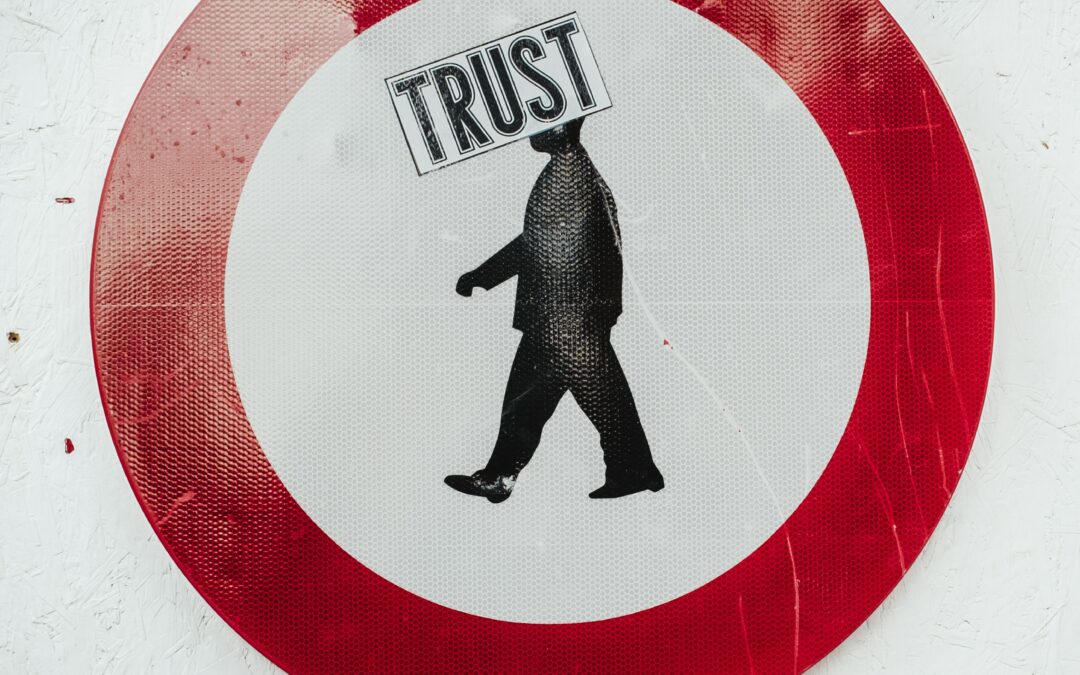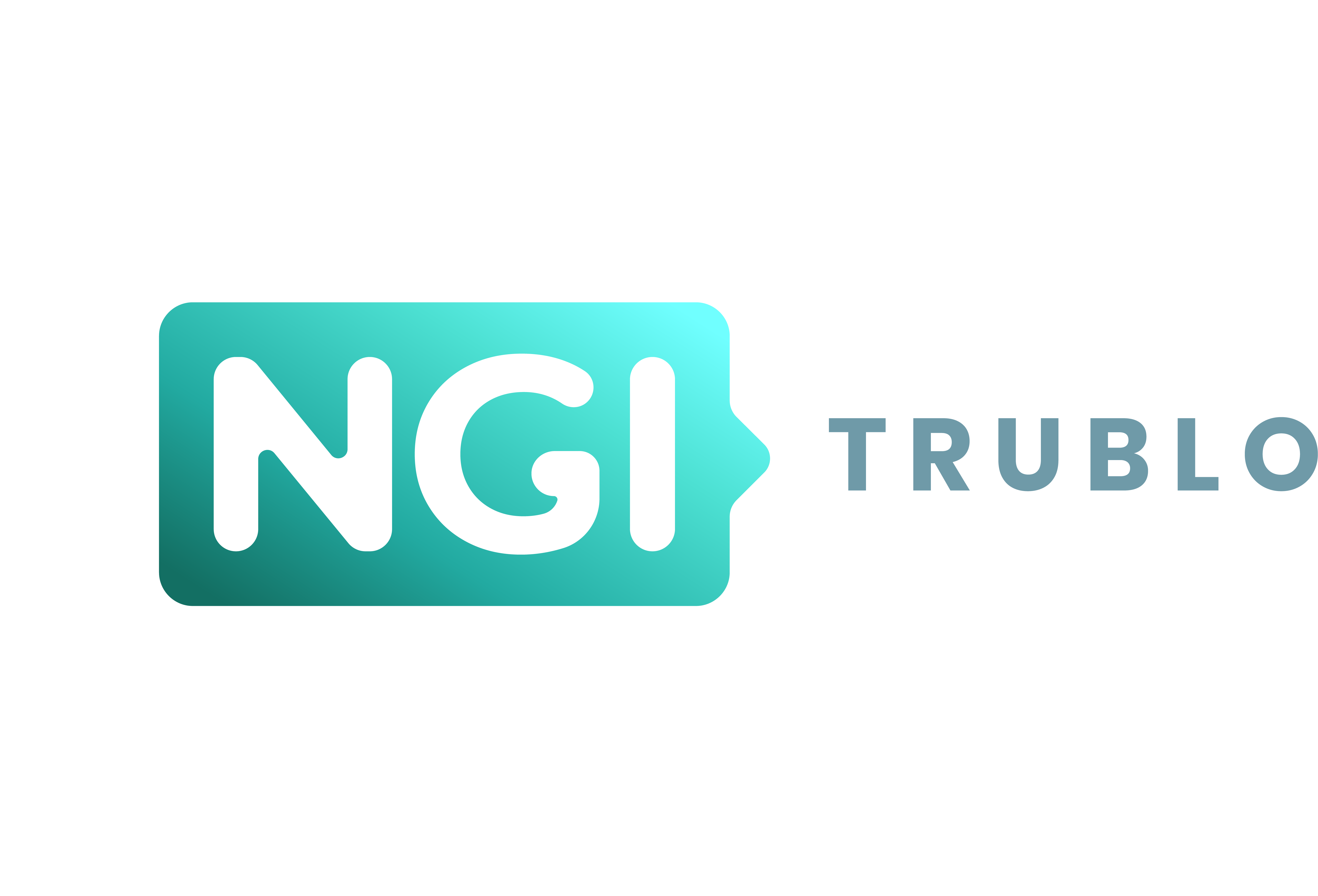
Five Minute Blockchain
Welcome to a new edition of the TruBlo newsletter. We are funding 45 early-stage blockchain ideas to explore new options for “trusted content on future blockchains”. A list of all TruBlo projects is here: https://www.trublo.eu/projects/
Our main question for selecting news and links: How is the field of blockchain, content and trust evolving?
Estimated reading time: 5 min 12 secs
Updates this week:
TRUST
FTC sues US data broker Kochava
The Federal Trade Commission (FTC) has filed a suit against Kochava, a US-based data broker.
“Kochava’s data can reveal people’s visits to reproductive health clinics, places of worship, homeless and domestic violence shelters, and addiction recovery facilities. The FTC alleges that by selling data tracking people, Kochava is enabling others to identify individuals and exposing them to threats of stigma, stalking, discrimination, job loss, and even physical violence. The FTC’s lawsuit seeks to halt Kochava’s sale of sensitive geolocation data and require the company to delete the sensitive geolocation information it has collected.”
FTC
The Guardian
Two-thirds of UK youth are not interested in crypto
A survey conducted by youth marketing agency Seed in May 2022 showed low interest in cryptocurrency among young people in Britain.
“Responses revealed that 66% of so-called ‘zoomers’ aged 18-24 are not interested in cryptocurrency, with 10% willing to try it but won’t prefer it over other investments. It canvassed 2,000 people during May, which was the depths of the crypto crash. Women are even less interested in crypto, with three-quarters giving it a thumbs down. In contrast, half of men are willing to give it a try.The situation for NFTs was even worse, with 70% believing non-fungible tokens (NFTs) are scams.”
Ledger Insights
Facebooks pervasive pixel
A study using technology from Mozilla reveals the extent of data collection around the world.
The Markup
People buying guns with cryptocurrency leave a digital trail
Gun owners in the USA want no or minimal data registration about purchases and ownership. But buying weapons with crypto could leave an unintentional digital trail.
Coindesk
CONTENT
Sources: Netflix plans to launch ad tier in November, to be ahead of Disney+
In July, the company announced to plan for the introduction in early 2023. Now it looks like the launch will be done earlier for markets in the US, Canada, UK, France and Germany.
Variety
Google blocks TruthSocial app because of violent content
TruthSocial is a social media platform initiated by former US president Donald Trump after being banned from Twitter. Now it seems Google will not allow the app to be downloaded via the Google Play Store.
Axios
TechCrunch
French government uses AI to detect undeclared swimming pools
In France, homeowners must declare a swimming pool for accurate property tax. Authorities are now using machine learning software to analyse aerial photos.
“The software, developed in partnership with the consulting firm Capgemini and the US digital giant Google, was tested in nine regions — Alpes-Maritimes, Var, Bouches-du-Rhône, Ardèche, Rhône, Haute-Savoie, Morbihan, Maine-et-Loire and Vendée — and revealed more than 20,000 undeclared swimming pools, according to a report by the directorate. “
Euronews
Twitter tests an edit button for Tweets
A tweet can be edited for up to 30 minutes, and the edit history will be shown to users. The feature has been requested for a long time, though critics feat that the edit option might open the door to misuse.
The Verge
Little kids yelling “poop” at Alexa are driving up profits for some songs
“Pecunia non olet” is a Latin proverb that means “Money does not smell”. Now, some musicians report that songs with the word “poop” are getting many plays. The assumption is that this happens because little kids yelling “poop” activate Alexa.
Buzzfeed
BLOCKCHAIN
Helium developers propose switching to Solana
According to a blog post by the Helium Foundation, the platform wants to free up resources needed to develop and maintain its own blockchain and instead plans to switch to Solana.
“Developers behind the Helium network – a grid of medium-range wireless hotspots pitched as an alternative to hard-wired internet service – are proposing to migrate away from the project’s own blockchain onto Solana, in pursuit of faster transaction speeds, higher uptimes and more interoperability with other blockchains as key reasons. The Helium Foundation wrote in a Medium post this week that the new proposal from the Helium core developer team would improve the operational efficiency “significantly.” The proposal to move toward Solana and away from Helium’s own blockchain, officially known as HIP 70, “addresses network speed, reliability and scalability”.
Coinbase
Web3 is going great
Misplaced decimal allowed traders in Georgia to cash out at 100x the regular price
Coinbase tries to get its money back after discovering that in late August, Georgia traders could cash out crypto at 100 times the intended market rate. The Georgian Lari (GEL) exchange rate was 290, not 2,90. As a result, an estimated 900 traders could sell their holdings at a considerable profit. Coinbase is now seeking payback; accounts have been locked in some cases. The misplaced decimal point was not detected for seven hours.
Blockworks
Market analysis: The state of crypto banks in 2022
Users: From October 2021 to May 2022, Crypto.com saw its user base grow from 10M to 50M, an increase of 400%. Similarly, the number of Nexo users doubled from over 2M to over 4M from September 2021 to May 2022. Crypto lending has surged over the last two years and publicizes a vision of financial services where lenders and borrowers avoid the traditional financial firms that position themselves as the gatekeepers for loans or other products.
Company size: While some crypto banks are facing hiring headwinds, others are unperturbed amid market volatility. In June 2022, BlockFi announced a 20% layoff — the company headcount dropped from about 850 in January to about 680 by the end of July. Meanwhile, Nexo’s LinkedIn headcount has jumped nearly 60% since January 2022.
Blockdata
Short links
- Google and YouTube outline plans for content moderation in US midterm elections TechCrunch
- How to add DuckDuck Go Privacy Essentials to your browser ZD Net
- Web3 Domain Name Service Could Lose Its Web Address Because Programmer Who Can Renew It Sits in Jail Coindesk
- Snap appears to have axed its Web3 team as part of the social media company’s decision to restructure and cut its headcount by about 20%. Blockworks
- 62% of wallets did not sell Bitcoin for a year amid a bear market Cointelegraph
Would you happen to have any feedback or suggestions? Contact us via info@trublo.eu
Photo by Bernard Hermant on Unsplash

August 25, 2022• Issue No. 39
Five Minute Blockchain
Welcome to a new edition of the TruBlo newsletter. We are funding 45 early-stage blockchain ideas to explore new options for “trusted content on future blockchains”. A list of all TuBlo projects is here: https://www.trublo.eu/projects/Our main question for selecting news and links below: How is the field .of blockchain, content and trust evolving?
Updates this week:
Estimated reading time: 4 min 10 sec
TRUST
Spyware use in Europe, homemade
In Greece, Thanassis Koukakis, a financial journalist, discovered spyware on his phone. This case seems to be part of a whole wave of spyware uses.
“Over the past 13 months, it has been revealed that spyware had targeted opposition leaders, journalists, lawyers and activists in France, Spain, Hungary, Poland and even staff within the European Commission, the EU’s cabinet-style government, between 2019 and 2021. The bloc has already set up an inquiry into its own use of spyware, but even as the 38-person committee works toward producing a report for early 2023, the number of new scandals is quickly mounting up.”
One key finding – the spyware was developed in Europe, not elsewhere:
“What sets the scandal in Greece apart is the company behind the spyware that was used. Until then the surveillance software in every EU scandal could be traced back to one company, the notorious NSO Group. Yet the spyware stalking Koukakis’ phone was made by Cytrox, a company founded in the small European nation of North Macedonia and acquired in 2017 by Tal Dilian—an entrepreneur who achieved notoriety for driving a high-tech surveillance van around the island of Cyprus and showing a Forbes journalist how it could hack into passing people’s phones. In that interview, Dilian said he had acquired Cytrox and absorbed the company into his intelligence company Intellexa, which is now thought to now be based in Greece. The arrival of Cytrox into Europe’s ongoing scandal shows the problem is bigger than just the NSO Group. The bloc has a thriving spyware industry of its own.”
WIRED
A deep dive into the fall of Three Arrows
Long report about the founders, set-up and the reasons for the downfall of the crypto hedge fund. Apparently, “playing with money” was a big part of it, sheltered by a hybrid that the complex technology would make the blundering hard to detect.
“Bear markets in crypto tend to make any stock-market action look like child’s play. The crashes are so severe that insiders call it “crypto winter,” and the season can last years. That’s where Three Arrows Capital found itself by the middle of January 2022, and it was poorly equipped to weather it. The GBTC position ate an ever-larger hole in 3AC’s balance sheet, and much of its capital was tied up in restricted shares in smaller crypto projects. Other arbitrage opportunities had dried up. In response, Three Arrows seems to have decided to ramp up the riskiness of its investments in hopes of scoring big and getting the firm back on a solid footing. “What made them change was just overreaching for returns,” says a major lending executive. “They were probably like, ‘What if we just go long? In February, Three Arrows took one of its biggest swings yet: It put $200 million into a buzzy token called luna, which was founded by a brash, alluring South Korean developer and Stanford dropout named Do Kwon, with whom Davies and Zhu had been hanging out in Singapore.”
New York Magazine
CONTENT
How a small, slightly different view might grow into deep distrust
Even if views on a complex issue differ, it should be possible to find a consensus for the best solution over time. A factor in this should be the amount of available information – the more, the better. That would be an assumption based on common sense. But it might not be true at all. Instead, the abundance of information might amplify small different views into deep distrust of “the other side”.
„We show that small biases may lead to substantial and persistent divergence in both trust in information sources and beliefs about facts, with partisans on each side trusting unreliable ideologically aligned sources more than accurate neutral sources and also becoming overconfi- dent in their own judgment.”
Could the abundance of information on the web and social media overwhelms and confuses humans? And that this leads to more extreme positions instead of compromise?
Stanford University
Dark Patterns: Bad when used by others, but ok when used by your company?
Benedict Evans points to two articles published in The New York Times: One criticising the use of “dark patterns” on technology platforms. And other technical articles where the news organisation talks about its optimisation to gradually funnel online visitors into subscriptions.
The use of technology to funnel first-time visitors gradually towards a possible subscription is not automatically a “dark pattern”. The expression describes UI/UX layouts of websites where users have difficulty saying “no”. Such patterns are used in all kinds of applications, often leading to complaints by users who only later find out they were tricked into consent for a setting, for marketing purposes or even a subscription which can not be cancelled anymore.
But Evans has a point that often, double standards apply to the use of
The technical report about using Machine Learning to gain more subscribers does not mention such approaches. But the point is: As everyone tries to optimise the business revenue, the occurrence of tricks, cover-ups and harmful business practices will likely not go down but up. One fact from the published article: After reaching 10 million paying subscribers, the NYT aims to reach 15 million by 2027. Such ambitious growth often applies tricks to achieve such goals in time. High pressure to reach goals was a significant reason for Volkswagen’s scandal around engine emissions.
The New York Times: Stopping the manipulation machines ($)
The New York Times: How The New York Times Uses Machine Learning To Make Its Paywall Smarter
BLOCKCHAIN
In Argentina, Crypto is more practical for many transactions than cash
A recurring doubt regarding the future of cryptocurrencies (and blockchain) is the question of practicality. Where is the practical, day-to-day use?
One country where this is different is Argentina, a country where cryptocurrencies have a growing appeal, despite the volatility.
Two main reasons: The local currency, the peso, has lost value for decades. The second problem is that banks have imposed restrictions on bank accounts. Having a bank account in another currency with a bank outside of Argentina is no real option because one would have to travel there to get the money. This is why many people in Argentina store money they have in bricks – they buy bricks when they have money and store them.
“Argentinians who use crypto are increasingly untethered from the local Argentinian economy and increasingly plugged into the global cloud economy. Crypto is providing new solutions to problems that Argentina has faced for generations, and many Argentinians are excited about its potential to make it easier and safer to make, use, and store money.”
Big Think
People in El Salvador want reliable banking.
“N1co is Central America’s first neobank, thriving because El Salvador still needs basic financial inclusion.”
Rest of World
Bitcoin Depot to go public at an $885 million valuation
The company is operating a network of Bitcoin ATMs in the US.
“Founded in 2016, Bitcoin Depot claims to be the largest provider of such ATMs in North America with more than 7,000 kiosks in the region. These ATMs function by connecting with a wallet and, after a verification process, allow the user to insert fiat money to receive BTC, LTC or ETH in their wallets.”
The Block
The percentage of crypto investors did not grow in the past 12 months
According to a survey by PEW Research, the number of people dealing with crypto has remained at the same level as a year before, at roughly 16%.
(In 2020) Pew researchers asked 10,371 Americans if they have “ever invested in, traded, or used a cryptocurrency.” Some 16 percent of Americans said they had. Last month, the nonprofit asked another sample group — slightly smaller, at 6,034 Americans — the same question. And again, 16 percent said they had invested or traded in the alternate currency.
Washington Post ($)
Related:
- 64% of crypto-versed parents want crypto to be taught in schools Cointelegraph
- 72% of Russians say they never bought Bitcoin Cointelegraph
Ethereum Merge to begin September 6
The Ethereum Foundation says it will begin the Merge on September 6, split into two parts, the second running between September 10-20
The Block
Short links
- cbETH: Coinbase offers liquid staking service & token for Ethereum ahead of the Merge The Block
- Authorities in Afghanistan shut down 16 crypto exchanges in one-week Coindesk
- Revenue is a feature. Some companies can think about it later; others must figure it out earlier. Benedict Evans
- Mana: “BlackRock for the new economy” TechCrunch
- BalkanID will use AI for Identity Governance TechCrunch.
- Privado helps developers be compliant with privacy laws Forbes
- ThirdWeb raises 24 million for web3 development kit TechCrunch
- Polygon founder launches fund with $50 million for web3 investments Cointelegraph
- How traditional banks cope with digital assets Blockdata
Thank You for reading. Please forward this newsletter to colleagues: Click here to subscribe.
Would you happen to have any feedback or suggestions? Contact us via info@trublo.eu
Photo by Clark Tibbs on Unsplash

August 12, 2022• Issue No. 37
Five Minute Blockchain
Welcome to a new edition of the TruBlo newsletter. We are funding 45 early-stage blockchain ideas to explore new options for “trusted content on future blockchains”. A list of all TuBlo projects is here: https://www.trublo.eu/projects/Our main question for the selection of news and links below: How is the field .of blockchain, content and trust evolving?
Updates this week:
Estimated reading time: 4 min 5 seconds
TRUST
US authorities on the hunt for Conti ransomware gang
U.S. authorities have named five members of a ransomware gang called Conti. There are rewards of up to 10 million US-Dollar for information leading to an arrest.
“The State Department said Conti has carried out over 1,000 ransomware operations targeting U.S. and international critical infrastructure, including law enforcement agencies, emergency medical services and 911 dispatch centers”.
TechCrunch
Trust, transparency and reliability are keys to Web3 success
“A Web3 world that removes traditional “middlemen” in favor of decentralization has the potential for creators and regular end users to gain more control over their data — but only if issues around digital trust, transparency and reliability are successfully addressed.”
Security Magazine
Mastercard survey: Awareness of crypto is high, but the industry needs to rebuild trust with consumers
Some data points from research by Mastercard:
- Crypto payments are rising in popularity across the globe. 93% of those surveyed have heard of cryptocurrency
- 41% have done at least one crypto-related activity in the past year
- Consumers are still looking for more stability within the industry
The Block
CONTENT
Data ownership redefines the relationship between artists and fans
“Over the course of the past two decades, Grammy Award-winning DJ, André Allen Anjos (also known as RAC) has noticed a growing trend. ‘There’s been a trend since 2005 in the MySpace era, and all of that has been a trend towards sovereignty of an artist, of putting the artists on top,’ he says.
RAC is an advisor to Audius — a decentralized music streaming platform that raised $5 million last September from big names including Coinbase Ventures and Pantera Capital, along with popular artists such as Jason Derulo and Katy Perry.
The Block
Facebook loses appeal to teens, study says
“Gen Z internet use is on the rise, but the rate at which teens use Facebook is rapidly declining. A Pew Research Center study on teens, technology and social media found that only 32% of teens aged 13-17 use Facebook at all, but in a previous survey from 2014-2015, that figure was 71%, beating out platforms like Instagram and Snapchat.” (Source: TechCrunch)
The most popular social network is YouTube
Pew Research Center
BLOCKCHAIN
Ethereum merge may be coming sooner than expected
The merge is now expected for September 15 or 16, 2022.
Background: “The Merge is set to transition the second-largest cryptocurrency Ethereum to its next phase (formerly known as Ethereum 2.0) as the network’s entire blockchain moves to a new system which proponents say will make it more efficient, sustainable and scalable.” (Source: TRT World).
Decrypt
Ethereum usage prices levelling out even before the merge
Costs for transactions and on-chain use on Ethereum are levelling out, as Coinbase reports. One reason: Lower usage, which results in lower demand.
Coinbase
Tornado Cash website goes dark after sanctions by U.S. Treasury
Background: “Tornado Cash is an open-source project that enables people to shield their transaction histories from public view. The U.S. government alleges it is also a service that was used to launder more than $7 billion worth of ill-gotten gains since 2019, including by North Korean hackers.”
On Friday, August 12. the Tornado Cash website was no longer reachable. Similarly, the Discord channel. Before Tornado Cash had been sanctioned by the U.S. Treasury on Monday this week. According to crypto news websites, all “American persons are barred from interacting with the open-source protocol”. (Via Coinbase)
Another view from David Gerard:
“Transactions on the Ethereum blockchain are completely traceable. Any transaction anyone ever made on Ethereum can be traced, all the way back to the launch of the project in 2015. Transactions are pseudonymous — but many users have been identified after the fact. Tornado Cash is a mixer — an Ethereum smart contract program that you can use to break the traceability of transactions on Ethereum. This is for privacy. Tornado Cash accepts deposits of ether (the currency on Ethereum) from one address and enables you to withdraw the ether from a different address. The smart contract works as a pool that mixes all deposits, using zero-knowledge proofs.” (Via David Gerard).
In Amsterdam, authorities arrested a Tornado developer.
Tornado DAO discusses legal avenues after being sanctioned (via The Block)
Study: Number of people working in the blockchain industry up by 76%
“The number of people working in the blockchain industry went up by 76% year-on-year as of June 2022, a study undertaken by the professional networking platform Linkedin and the crypto trading app OKX has found. The study also found there is “a large gap in demand for technical talent in the global blockchain talent pool.'”
Bitcoin.com
Thank You for reading. Please forward this newsletter to colleagues: Click here to subscribe.
Do you have feedback or suggestions? Contact us via info@trublo.eu.
Photo by Pawel Czerwinski on Unsplash

30.06.2022 • Issue No. 35
Five Minute Blockchain
Updates from the intersection of trust, content and blockchain. What are notable developments?
This newsletter is published by the TruBlo project. We are funding 45 early-stage blockchain ideas to explore new options for “trusted content on future blockchains”. A list of all TuBlo projects is here: https://www.trublo.eu/projects/.
Updates this week
Estimated reading time: 5 min 44 seconds
TRUST
FBI says LinkedIn used for crypto scams
“In a typical scenario, according to the report, a scammer will pose as a professional with a fake profile and reach out to a LinkedIn user, starting with small talk before elevating to an offer to make money through crypto investments. Eventually, the scammer leverages the trust earned over months to direct the user to invest money to a site controlled by the perpetrator, and then drains the account.”
Coindesk
German telcos test new advertising technology, resulting in concerns by privacy advocates
In Germany, Deutsche Telekom and Vodafone, the two largest mobile providers are currently testing a new advertising technology called TrustPid.
“TrustPid allows mobile carriers to generate pseudo-anonymous tokens based on a user’s IP address that are administered by a company also named TrustPid. Each user is assigned a different token for each participating website they visit, and these can be used to provide personalised product recommendations—but in what TrustPid calls “a secure and privacy-friendly way.” That “privacy-friendly” part has raised critics’ hackles.”
In essence, the question is whether or not the new technology would allow for personal tracking. A spokesperson from Vodafone answering to Wired denied that this would be possible.
WIRED
CONTENT
New York Times with solid growth of website traffic
The New York Times is currently one of the fastest-growing news websites. The website got 524 million visits in May 2022, an increase of 52% compared to last year. A big driver for the traffic growth has been the acquisition of Wordle, a popular online game. The NYT purchased the game in February 2022. Another website with solid traffic growth is the Daily Mail (UK), with an increase of 14% to 373 million. For comparison: The website of CNN has even higher total traffic (641 million) but not as much growth (4%).
List of the top 50 most popular news websites in the world
Press-Gazette
Netflix starts tier with advertising
Netflix will introduce a new tier supported by advertising. After years of solid growth, the company had recently lost around 200.000 subscribers. The idea is to reach an audience which would not pay the monthly subscription.
“We’ve left a big customer segment off the table, which is people who say: ‘Hey, Netflix is too expensive for me, and I don’t mind advertising”, Netflix Co-CEO Ted Sarandos said in an interview. “… we’re not adding ads to Netflix as you know it today. We’re adding an ad tier for folks who say, ‘Hey, I want a lower price, and I’ll watch ads.”
Based on reports, Google will organise the sales for such Netflix advertising.
Hollywood Reporter
China wants to censor all social comments in advance
A new proposal by a regulator in China aims to approve all social media comments in advance. It is not clear how this would be done technically. The assumption is that it would be an automated service.
“On June 17, the internet regulator Cyberspace Administration of China (CAC) published a draft update on the responsibilities of platforms and content creators in managing online comments. One line stands out: all online comments must be pre-reviewed before being published. Users and observers are worried that the move could further tighten freedom of expression in China.”
Related: The New York Times has a visual report showing how surveillance technology in China works and how it has expanded in recent years:
“China’s ambition to collect a staggering amount of personal data from everyday citizens is more expansive than previously known, a Times investigation has found. Phone-tracking devices are now everywhere. The police are creating some of the largest DNA databases in the world. And the authorities are building upon facial recognition technology to collect voice prints from the general public.”
MIT Technology Review
The New York Times ($)
Notes: Twitter adds a long-form text option
Twitter will add a new feature called ‘Notes’, which then can be attached directly to a tweet. The idea is that content creation and tweet promotion can be done on one platform. Market observers view it as an experiment; it is unclear whether this will catch on. Twitter is testing the feature with several writers. So far, the quality is not available in all world regions, e.g., Europe.
Twitter
Khaby Lame rises to most followed TikTok creator
Lame, who rose to popularity with comedy reactions to other TikToks now has 142 million followers on TikTok.
Techcrunch
Khaby Lame TikTok
Wikipedia
BLOCKCHAIN
Falling prices testing platforms
The falling values of cryptocurrencies create all kinds of challenges. Example: Last week, users of Solend, a Solana-based protocol, voted to take over an account to prevent a margin call. The original user had borrowed $108 million but was getting under pressure to liquidate if the Solana token would fall below $22,30. Managers of Solend used “emergency powers” to take over the wallet. However, this decision was met with an outcry by users as a violation of the principle of decentralised decisions through code, not by single humans. While this is only one episode, the current situation in the crypto market creates all kinds of issues and pressure to invent policies for crises.
Coinbase
Three Arrows Capital ordered to be liquidated
The end of the crypto speculation bubble affects all kinds of Blockchain companies. Some of them are in crisis mode. Many watched the liquidity crisis in the past week at Celsius and BlockFi. Another firm in trouble is ThreeArrows Capital, which is based in Singapore. Sky News reported that a British Virgin Islands court had ordered the fund’s liquidation.
“The firm’s demise is likely to raise further questions, however, about the regulatory oversight to which cryptocurrencies and other digital assets are subject in the world’s major financial centres.”
The collapse of such prominent players sends shockwaves yet to other companies:
“Cryptocurrency market maker and lending firm Genesis Trading is facing potential losses into the “hundreds of millions,” according to three people familiar with the matter.”
Sky
Coindesk
Hackers steal $100 million exploiting bridge
The Harmony blockchain, used as a bridge to exchange tokens of different blockchains, has been hacked.
“Hackers looted about $100 million from a so-called cryptocurrency bridge, again exposing a key vulnerability in the digital-asset ecosystem.”
“…bridges are particularly vulnerable to hacks, as their technology is complex and they are often run by anonymous teams. The way they safeguard funds is often unclear. Sophisticated hackers have repeatedly targeted them. ”
Bloomberg
Short links:
• After the big crash, entrepreneur Do Kwon still wants to offer a new coin Wall Street Journal
Thank You for reading. Please forward this newsletter to colleagues: Click here to subscribe.
Do you have feedback or suggestions? Contact us
Photo by Clay Banks on Unsplash

Webinar powered by NGI TETRA and NGI TruBlo.
When: 2 June 2022 | 15:00 CEST
Where: Online
Registration: https://meet.zoho.eu/iBWV0Wuwxw
As your customer base grows and you start to make a profit, it’s only natural to start thinking about your next steps and ask yourself: is it time to scale?
But where to start and what are the next steps to take? Scaling can be full of challenges and premature scaling is considered to be one of the main reasons why young companies fail.
At this webinar we will talk about:
- What are the key questions to ask before scaling?
- What is premature scaling?
- What are the components of a good “ready to scale checklist”?
Speakers
.jpg) Andrej Petrus is investment Manager @ ZAKA – venture capital family office investing primarily in the pre-seed and seed stage (50-500k EUR) in CEE region. Agile generalist with experiences in venture building for CEAi and M&A and Strategy consultancy for PwC in Prague. Assisting the Board of Directors of SLOVCA (Slovak Venture Capital and Private Equity Association) as Project Manager.
Andrej Petrus is investment Manager @ ZAKA – venture capital family office investing primarily in the pre-seed and seed stage (50-500k EUR) in CEE region. Agile generalist with experiences in venture building for CEAi and M&A and Strategy consultancy for PwC in Prague. Assisting the Board of Directors of SLOVCA (Slovak Venture Capital and Private Equity Association) as Project Manager.
LinkedIn
 Donnie Sc Lygonis works as an Innovation Strategist and Business Coach at KTH Innovation, the innovation office at The Royal Institute of Technology in Stockholm. He has been working with entrepreneurship and innovation for over 25 years, both running his own companies or helping others start theirs. He is an appreciated speaker on innovation and creativity, having spoken at 5 TEDx events and been part of 3 separate TV-series on innovation.
Donnie Sc Lygonis works as an Innovation Strategist and Business Coach at KTH Innovation, the innovation office at The Royal Institute of Technology in Stockholm. He has been working with entrepreneurship and innovation for over 25 years, both running his own companies or helping others start theirs. He is an appreciated speaker on innovation and creativity, having spoken at 5 TEDx events and been part of 3 separate TV-series on innovation.
LinkedIn
KTH Readiness System
You will be introduced to the KTH Readiness System, a unique and effective approach for self-assessment of how far your project has evolved. There are many, many approaches how to getting an idea off the ground and transforming it into a real world. One approach which should be known more widely is the KTH Readiness Level. It is a simple, yet very effective and helpful approach to letting an idea evolve, step by step. The approach comes from the Royal Institute of Technology in Stockholm (KTH).
Brief overview
Originally developed as a step-by-step development approach for technology at NASA, the KTH Readiness System has extended to seven dimensions that are relevant for every new idea. The key questions are: How ready is your idea to be used by customers, how far evolved are the development steps for the technology, the business model, the IPR, the team and the funding.
Each of these dimensions will be checked against a grade scale, which starts at one and has the highest level at nine. The scales are visualised as thermometers. The visualization is used as a simple tool to enable an assessment of the founders, potential funders and other stakeholders. The system is very simple to use and helps to align the many possible activities of a start-up into a logical build-up process.
For illustration, here are the levels to work on for the business model. The process starts at the bottom, at level 1. In this process, an early, unclear business idea is gradually filled with assumptions, gradually described and then checked for viability through tests with potential clients. Based on the findings there is an added business model, early pricing and projections for revenue.

In total there are six Innovation Readiness Levels:
- Customer Readiness Level (CRL): To confirm customer needs and interest
- Technology Readiness Level (TRL): To develop and test the technology, product, service, or concept
- Business Model Readiness Level (BRL): To establish that the concept can be financially, environmentally, and socially viable and feasible
- IPR Readiness Level (IPRL): To clarify the legal and IP situation and secure relevant IP protection
- Team Readiness Level ( TMRL): To secure the right competencies and align the team
- Funding Readiness Level (FRL): To secure the necessary funding to take the idea to the market
Value and benefits
The KTH Innovation Readiness Level is a tool with many applications that adds value for several users and stakeholders (idea owners, coaches, managers, and external partners). For example:
- Snapshot of status and maturity – use the tool to quickly and without bias assess the maturity and current development status of an idea
- Reality check – the tool enables idea owners to more objectively define their progress across several important dimensions
- Coaching and communication – offering clear and defined terminology and a visual model allow coaches, advisors, and idea owners to communicate effectively around the idea development. It also provides a structure for individual meetings as well as the entire process
- Guidance – the model provides key steps and questions that need to be addressed and gives a clear roadmap for both coaches and idea owners throughout the process
- Portfolio management – the possibility to quantify and visualise the development progress of the ideas in your entire portfolio can generate useful metrics that help your organisation to objectively and fairly allocate resources and in other ways control and guide your innovation support process
The model is built to align with and include the current best practices and well-known methodologies in innovation development such as the lean startup methodology, the business model/lean canvas, etc.
More info:
https://kthinnovationreadinesslevel.com






.jpg) Andrej Petrus is investment Manager @ ZAKA – venture capital family office investing primarily in the pre-seed and seed stage (50-500k EUR) in CEE region. Agile generalist with experiences in venture building for CEAi and M&A and Strategy consultancy for PwC in Prague. Assisting the Board of Directors of SLOVCA (Slovak Venture Capital and Private Equity Association) as Project Manager.
Andrej Petrus is investment Manager @ ZAKA – venture capital family office investing primarily in the pre-seed and seed stage (50-500k EUR) in CEE region. Agile generalist with experiences in venture building for CEAi and M&A and Strategy consultancy for PwC in Prague. Assisting the Board of Directors of SLOVCA (Slovak Venture Capital and Private Equity Association) as Project Manager. Donnie Sc Lygonis works as an Innovation Strategist and Business Coach at KTH Innovation, the innovation office at The Royal Institute of Technology in Stockholm. He has been working with entrepreneurship and innovation for over 25 years, both running his own companies or helping others start theirs. He is an appreciated speaker on innovation and creativity, having spoken at 5 TEDx events and been part of 3 separate TV-series on innovation.
Donnie Sc Lygonis works as an Innovation Strategist and Business Coach at KTH Innovation, the innovation office at The Royal Institute of Technology in Stockholm. He has been working with entrepreneurship and innovation for over 25 years, both running his own companies or helping others start theirs. He is an appreciated speaker on innovation and creativity, having spoken at 5 TEDx events and been part of 3 separate TV-series on innovation.